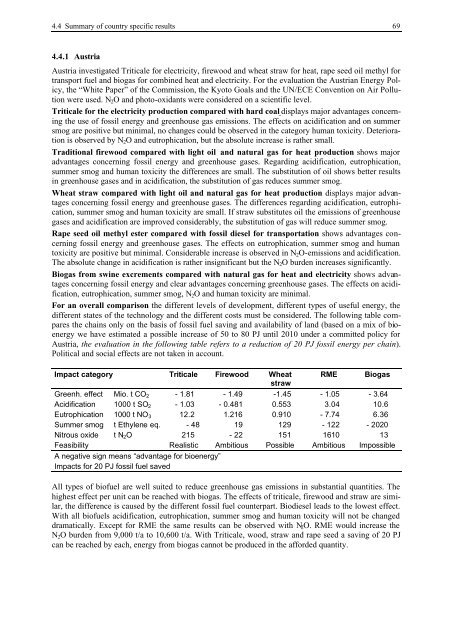BIOENERGY FOR EUROPE: WHICH ONES FIT BEST?
BIOENERGY FOR EUROPE: WHICH ONES FIT BEST?
BIOENERGY FOR EUROPE: WHICH ONES FIT BEST?
Create successful ePaper yourself
Turn your PDF publications into a flip-book with our unique Google optimized e-Paper software.
4.4 Summary of country specific results 69<br />
4.4.1 Austria<br />
Austria investigated Triticale for electricity, firewood and wheat straw for heat, rape seed oil methyl for<br />
transport fuel and biogas for combined heat and electricity. For the evaluation the Austrian Energy Policy,<br />
the “White Paper” of the Commission, the Kyoto Goals and the UN/ECE Convention on Air Pollution<br />
were used. N2O and photo-oxidants were considered on a scientific level.<br />
Triticale for the electricity production compared with hard coal displays major advantages concerning<br />
the use of fossil energy and greenhouse gas emissions. The effects on acidification and on summer<br />
smog are positive but minimal, no changes could be observed in the category human toxicity. Deterioration<br />
is observed by N2O and eutrophication, but the absolute increase is rather small.<br />
Traditional firewood compared with light oil and natural gas for heat production shows major<br />
advantages concerning fossil energy and greenhouse gases. Regarding acidification, eutrophication,<br />
summer smog and human toxicity the differences are small. The substitution of oil shows better results<br />
in greenhouse gases and in acidification, the substitution of gas reduces summer smog.<br />
Wheat straw compared with light oil and natural gas for heat production displays major advantages<br />
concerning fossil energy and greenhouse gases. The differences regarding acidification, eutrophication,<br />
summer smog and human toxicity are small. If straw substitutes oil the emissions of greenhouse<br />
gases and acidification are improved considerably, the substitution of gas will reduce summer smog.<br />
Rape seed oil methyl ester compared with fossil diesel for transportation shows advantages concerning<br />
fossil energy and greenhouse gases. The effects on eutrophication, summer smog and human<br />
toxicity are positive but minimal. Considerable increase is observed in N2O-emissions and acidification.<br />
The absolute change in acidification is rather insignificant but the N2O burden increases significantly.<br />
Biogas from swine excrements compared with natural gas for heat and electricity shows advantages<br />
concerning fossil energy and clear advantages concerning greenhouse gases. The effects on acidification,<br />
eutrophication, summer smog, N2O and human toxicity are minimal.<br />
For an overall comparison the different levels of development, different types of useful energy, the<br />
different states of the technology and the different costs must be considered. The following table compares<br />
the chains only on the basis of fossil fuel saving and availability of land (based on a mix of bioenergy<br />
we have estimated a possible increase of 50 to 80 PJ until 2010 under a committed policy for<br />
Austria, the evaluation in the following table refers to a reduction of 20 PJ fossil energy per chain).<br />
Political and social effects are not taken in account.<br />
Impact category Triticale Firewood Wheat<br />
straw<br />
RME Biogas<br />
Greenh. effect Mio. t CO2 - 1.81 - 1.49 -1.45 - 1.05 - 3.64<br />
Acidification 1000 t SO2 - 1.03 - 0.481 0.553 3.04 10.6<br />
Eutrophication 1000 t NO3 12.2 1.216 0.910 - 7.74 6.36<br />
Summer smog t Ethylene eq. - 48 19 129 - 122 - 2020<br />
Nitrous oxide t N2O 215 - 22 151 1610 13<br />
Feasibility Realistic Ambitious Possible Ambitious Impossible<br />
A negative sign means “advantage for bioenergy”<br />
Impacts for 20 PJ fossil fuel saved<br />
All types of biofuel are well suited to reduce greenhouse gas emissions in substantial quantities. The<br />
highest effect per unit can be reached with biogas. The effects of triticale, firewood and straw are similar,<br />
the difference is caused by the different fossil fuel counterpart. Biodiesel leads to the lowest effect.<br />
With all biofuels acidification, eutrophication, summer smog and human toxicity will not be changed<br />
dramatically. Except for RME the same results can be observed with N2O. RME would increase the<br />
N2O burden from 9,000 t/a to 10,600 t/a. With Triticale, wood, straw and rape seed a saving of 20 PJ<br />
can be reached by each, energy from biogas cannot be produced in the afforded quantity.

















